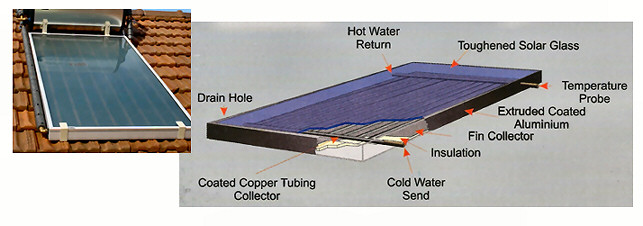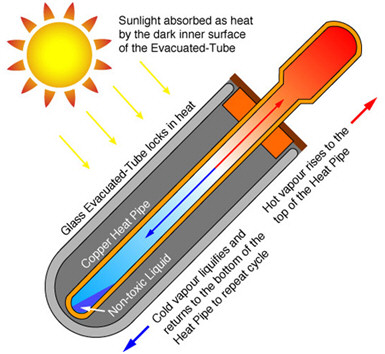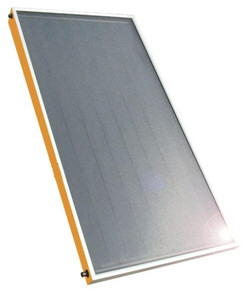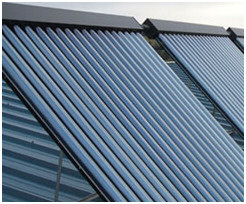Solar Collection Systems
Two types of solar collectors are used for residential applications:
Flat-plate collector – Glazed flat-plate collectors are insulated, weatherproofed boxes that contain a dark absorber plate under one or more glass or plastic (polymer) covers.

Evacuated-tube solar collectors – They feature parallel rows of transparent glass tubes. Each tube contains a glass outer tube and metal absorber tube attached to a fin. The fin’s coating absorbs solar energy but inhibits radiative heat loss. These collectors are used more frequently for U.S. commercial applications.

Flat-plate Collector Systems vs Evacuated Tubes
One of the most frequently-asked questions in the South African solar industry at present is whether one should purchase a Flat-Plate Collector Solar System or an Evacuated Tube Solar System. Before we elaborate on this it is important to understand the key differences between the two systems:
 The Flat-Plate Collector System is the traditional solar system comprising of a solar panel which is approx 80mm thick and ranges in size anywhere from 1.5 sq. m to 4 sq. m. The solar panel is mounted on the roof and is connected to a solar geyser which can also be installed on top of the roof (above the panel) or inside the ceiling. Flat-plate collector panels have been around since the 1950’s and whilst the materials used in the manufacture of the solar panels have improved over time, the technology within the system is largely the same. The system utilizes the thermosyphon principle whereby cold water is fed into the bottom of the solar panel, and as the panel is heated by the sun the water in turn is heated and automatically starts to rise to the top of the solar panel from where it is then fed into the solar geyser. The Flat-Plate Collector System is a tried and tested system which has provided thousands of people with solar-heated water for decades.
The Flat-Plate Collector System is the traditional solar system comprising of a solar panel which is approx 80mm thick and ranges in size anywhere from 1.5 sq. m to 4 sq. m. The solar panel is mounted on the roof and is connected to a solar geyser which can also be installed on top of the roof (above the panel) or inside the ceiling. Flat-plate collector panels have been around since the 1950’s and whilst the materials used in the manufacture of the solar panels have improved over time, the technology within the system is largely the same. The system utilizes the thermosyphon principle whereby cold water is fed into the bottom of the solar panel, and as the panel is heated by the sun the water in turn is heated and automatically starts to rise to the top of the solar panel from where it is then fed into the solar geyser. The Flat-Plate Collector System is a tried and tested system which has provided thousands of people with solar-heated water for decades.
 The Evacuated Tube Collector System is a much newer system which has been available in South Africa for around 2 years. With this system a series of cylindrical glass tubes are attached to a frame and installed on top of a roof. Each tube is approx 1.9m long and inside each tube is a copper rod which extends from the bottom to the top of the tube and then into a manifold. A special chemical formula inside each tube starts to boil between 30 and 40 degrees celsius. This quickly heats up the copper rods in each tube which in turns heats the water which passes through the manifold. The manifold in turn is connected to a geyser (some evacuated tube systems are connected directly to a geyser instead of a manifold).
The Evacuated Tube Collector System is a much newer system which has been available in South Africa for around 2 years. With this system a series of cylindrical glass tubes are attached to a frame and installed on top of a roof. Each tube is approx 1.9m long and inside each tube is a copper rod which extends from the bottom to the top of the tube and then into a manifold. A special chemical formula inside each tube starts to boil between 30 and 40 degrees celsius. This quickly heats up the copper rods in each tube which in turns heats the water which passes through the manifold. The manifold in turn is connected to a geyser (some evacuated tube systems are connected directly to a geyser instead of a manifold).
Which System Is Best?
It is a fact that Evacuated Tubes heat up faster than their Flat-Plate collector counterparts and are capable of attaining higher temperatures. Evacuated Tube systems can exceed boiling point quite easily if allowed. The cylindrical shape of the tubes also means that they lie at right-angles to the sun so they are in direct sunlight early in the morning and late in the afternoon. However, one’s skin can only tolerate water temperature of little over 40 degrees Celsius so don’t let the higher temperature capability be the sole consideration in choosing your system. In addition the higher the temperature the more cold water you will need to mix in order to bring the temperature down to a level which your skin can tolerate.
The glass tube are fragile and whilst they need to be a minimum of 2mm thick and pass a hail-test in order to receive SABS-test accreditation, they may break if they are dropped or come into contact with a stone or golf-ball. The tubes can also lose their evacuated state over time which will require replacement of the tube.
Flat-plate collectors on the other hand attain temperatures on average between 70 and 80 degrees in summer, and do not enjoy the direct sunlight of their Evacuated Tube counterparts early morning and late afternoon as the sun needs to reach a higher elevation before sunlight directly strikes the Flat-Plate collector. The Flat-Plate panels are however much stronger and more durable than the tubes and a quality flat-plate collector panel will generally enjoy a longer lifespan than an Evacuated Tube collector panel.
So to summarize, Evacuated Tubes reach higher temperatures and heat up faster, but are more fragile and have a lesser lifespan. Flat-Plate collector panels are more durable and will last longer, but reach lower temperatures.
If I were building a new home or renovating I would go for the Flat-Plate option as it will last longer. If I had an electric geyser less than 5 years old I would go for the Evacuated Tube Retrofit option whereby the electric geyser is converted to a solar geyser and connected to an Evacuated Tube Collector Panel.
